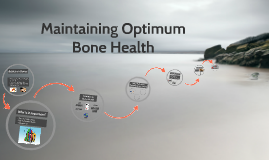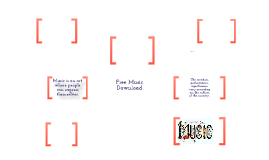Bone Health
Transcript: The Road to Strong Bones Susie Schneider, RD Healthy Bones Lifestyle Healthy Bones Follow a healthy, well balanced diet Be sure to get adequate calcium and vitamin D Avoid smoking and limit alcohol intake Avoid excessive caffeine intake Engage in regular exercise, especially weight-bearing exercises Are you at increased risk for bone issues?... Risk Factors Uncontrollable Risk Factors >50 years old female gender menopause family history of osteoporosis small frame Controllable Risk Factors poor diet habits not getting enough calcium or vitamin D excessive intake of sodium excessive intake of alcohol or caffeine tobacco use sedentary lifestyle Peak Bone Mass (PBM) PBM PBM is the greatest amount of bone an individual can attain PBM is reached in the late teens early 20s children and adolescents who have higher PBM reduce their risk of osteoporosis later in life Even if you are past PBM years, talk to the younger generations in your own life about optimizing their bone mass Calcium Calcium Most abundant mineral in the body and is important for building and maintaining strong bones 1% of calcium in the body is in blood, muscle and intracellular fluids 99% of the body's calcium supply is stored in the bones and teeth where it supports their structure and function Calcium is required for vascular contraction and dilation, muscle function, nerve transmission, intracellular signaling and hormonal secretion If we do not consume enough calcium from food, our body pulls from our bone Recommended Dietary Allowance RDA Estimated calcium intake by: National Health and Nutrition Examination Survey (NHANES) 2003 - 2006 Calcium Intake average for males aged 1 year+ 871 - 1266 mg/day average for females aged 1 year+ 748 - 968 mg/day inadequate calcium intake remains a concern for several age groups females aged 4 years + males aged 9 - 18 males aged 51 years + females are less likely than males to get adequate amounts of calcium from food Upper Limit It is not common to get too much calcium from food alone Side effects of too much calcium: constipation might interfere with the body's ability to absorb iron and zinc might increase risk of kidney stones (from excess dietary supplements) Is more better? Calcium in Food dairy: milk, cheese, yogurt fortified non-dairy milk alternatives: soy, almond/nut, rice milks non-dairy sources: leafy greens such as collards and kale fish with soft bones that can be eaten fortified food products such as cereal, oatmeal, tofu and OJ Food Sources Calcium Content Anti-nutrients & Absorption anti-nutrient: nutrients that can block absorption of other nutrients phytic acid and oxalic acid can bind to calcium and inhibit its absorption phytic acid: whole grains such as wheat bran, beans, seeds and nuts oxalic acid: spinach, collard greens, sweet potatoes, rhubarb and beans Absorption % Absorbed Eat a variety of foods The Takeaway "Though certain foods may contain residual amounts of anti-nutrients after processing and cooking, the health benefits of eating these foods outweigh any potential negative nutritional effects. Eating a variety of nutritious foods daily and avoiding eating large amounts of a single food at one meal can help to offset minor losses in nutrient absorption caused by anti-nutrients." - Harvard School of Public Health, Are anti-nutrients harmful "For people who eat a variety of foods, these interactions probably have little or no nutritional consequence and, furthermore, are accounted for in the overall calcium DRIs, which factor in differences in absorption of calcium in mixed diets" - NIH calcium fact sheet MYTH too much protein is bad for bones while it is true that calcium excretion increases as protein intake increases, so does calcium absorption, leading to no net loss in calcium adequate protein is particularly important for bone health in children and adolescents Protein Intake Enriched and Fortified Foods enriched: nutrients lost during food processing and have been added back enriched breads, grains, and waffles fortified: vitamins or minerals have been added to a food that were not originally in the food fortified cereals, OJ, almond milk, soy milk Reading Labels Calcium Supplements calcium carbonate most commonly available inexpensive absorbed best when taken with food calcium citrate absorbed equally well when taken with or without food useful for people with achlorhydria, IBD or absorption disorders gluconate, lactate, and phosphate poorly absorbed Supplements When a supplement may be warranted... Do I need a supplement? milk allergy or intolerance picky eater vegetarian/vegan family history of osteoporosis history of previous fractures no more than 500 mg dose of calcium at one time for best absorption avoid taking calcium at same time as iron Potential side effects... gastrointestinal side effects may include gas, bloating or constipation calcium carbonate appears to cause more GI effects than citrate consider spreading calcium dose throughout the day and/or taking

















